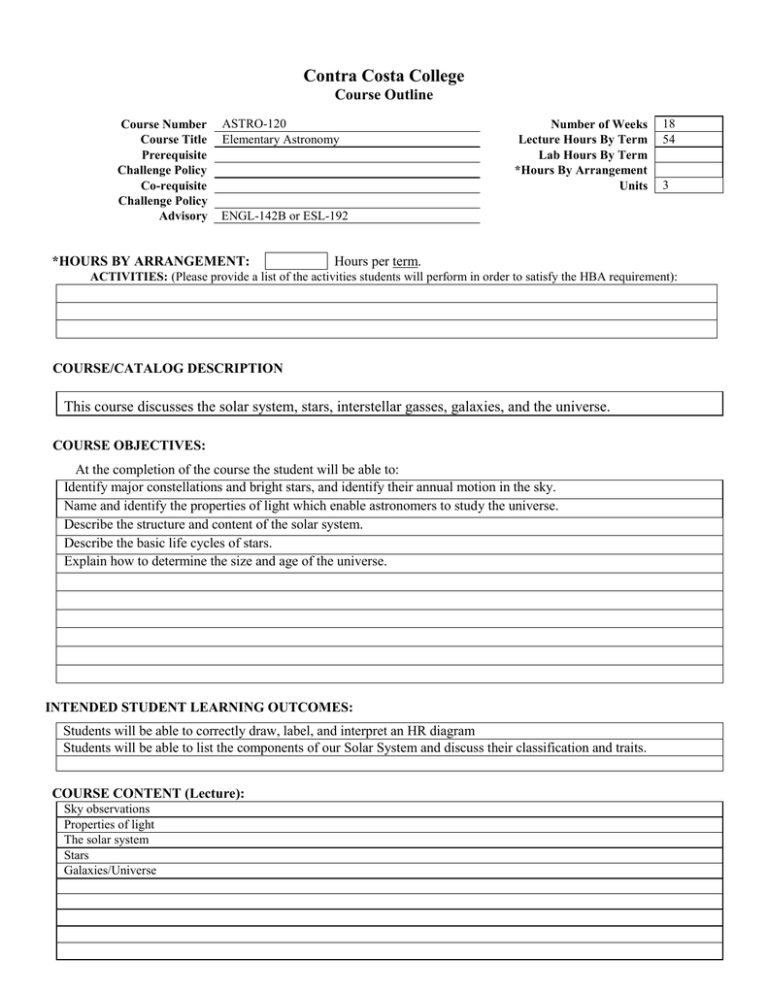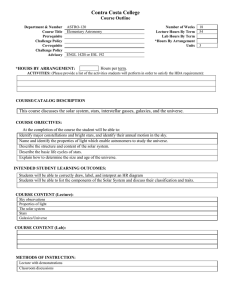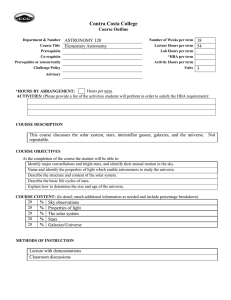ASTRO 120-S15.doc 98KB Feb 04 2015 11:10:25 AM
advertisement

Contra Costa College Course Outline Course Number Course Title Prerequisite Challenge Policy Co-requisite Challenge Policy Advisory ASTRO-120 Elementary Astronomy Number of Weeks Lecture Hours By Term Lab Hours By Term *Hours By Arrangement Units 18 54 3 ENGL-142B or ESL-192 *HOURS BY ARRANGEMENT: Hours per term. ACTIVITIES: (Please provide a list of the activities students will perform in order to satisfy the HBA requirement): COURSE/CATALOG DESCRIPTION This course discusses the solar system, stars, interstellar gasses, galaxies, and the universe. COURSE OBJECTIVES: At the completion of the course the student will be able to: Identify major constellations and bright stars, and identify their annual motion in the sky. Name and identify the properties of light which enable astronomers to study the universe. Describe the structure and content of the solar system. Describe the basic life cycles of stars. Explain how to determine the size and age of the universe. INTENDED STUDENT LEARNING OUTCOMES: Students will be able to correctly draw, label, and interpret an HR diagram Students will be able to list the components of our Solar System and discuss their classification and traits. COURSE CONTENT (Lecture): Sky observations Properties of light The solar system Stars Galaxies/Universe COURSE CONTENT (Lab): METHODS OF INSTRUCTION: Lecture with demonstrations Classroom discussions In-class group work INSTRUCTIONAL MATERIALS: NOTE: To be UC/CSU transferable, the text must be dated within the last 7 years OR a statement of justification for a text beyond the last 7 years must be included. Textbook Title: Author: Publisher: Edition/Date: Justification Statement: Textbook Reading Level: Your Astronomy Coach Jon Celesia Pearson 1st Edition, 2012 (For textbook beyond 7 years) Lab Manual Title Author: Publisher: Edition/Date: OUTSIDE OF CLASS WEEKLY ASSIGNMENTS: Title 5, section 55002.5 establishes that a range of 48 -54hours of lecture, study, or lab work is required for one unit of credit. For each hour of lecture, students should be required to spend an additional two hours of study outside of class to earn one unit of credit. Title 5, section 55002(a) 2F establishes that coursework calls for critical thinking and the understanding and application of concepts determined by the curriculum committee to be at college level. For degree applicable courses: List one example of critical thinking homework Outside of Class Weekly Assignments Hours per week Weekly Reading Assignments (Include detailed assignment below, if applicable) 3 Skim read all of Ch.1 Observing the Sky in Wonder; Carefully read and take notes on Ch.1 through planets. Weekly Writing Assignments (Include detailed assignment below, if applicable) 1 Make 3 lists: 10-20 brightest stars and their apparent magnitudes; 10-20 closest stars and their distances in lightyears; 10-20 most luminous stars and their luminosities relative to Sun. Critical thinking homework example: If there is a total solar eclipse on September 4, when is the next time that a lunar eclipse can occur? When is the earliest date that there could be another solar eclipse? When is the next time after that that there could be another solar eclipse? Weekly Math Problems (Include detailed assignment below, if applicable) 2 Complete the Ch.1-A online homework assignment. Lab or Software Application Assignments (Include detailed assignment below, if applicable) Other Performance Assignments (Include detailed assignment below, if applicable) STUDENT EVALUATION: (Show percentage breakdown for evaluation instruments) Title 5, section 55002 (a) 2A establishes that the grade is based on demonstrated proficiency in subject matter and the ability to demonstrate that proficiency. For degree applicable courses: Course requires essay writing, or, in courses where the curriculum committee deems them to be appropriate, by problem solving exercises, or skills demonstrations by students. 60 25 15 % Essay % Computation or Non-computational Problem Solving Skills % Skills Demonstration % Objective Examinations % % % Other (describe) Lab assignments Homework In class group work and quizzes GRADING POLICY: (Choose LG, P/NP, or SC) Pass / No Pass x Letter Grade 90% - 100% = A 80% - 89% = B 70% - 79% = C 60% - 69% = D Below 60% = F 70% and above = Pass Below 70% = No Pass Student Choice 90% - 100% = A 80% - 89% = B 70% - 79% = C 60% - 69% = D Below 60% = F Percentages vary from instructor to instructor Or 70% and above = Pass Below 70% = No Pass Prepared by: Jon Celesia and Mark Wong Date: Spring 2015 Revised form 09/14




